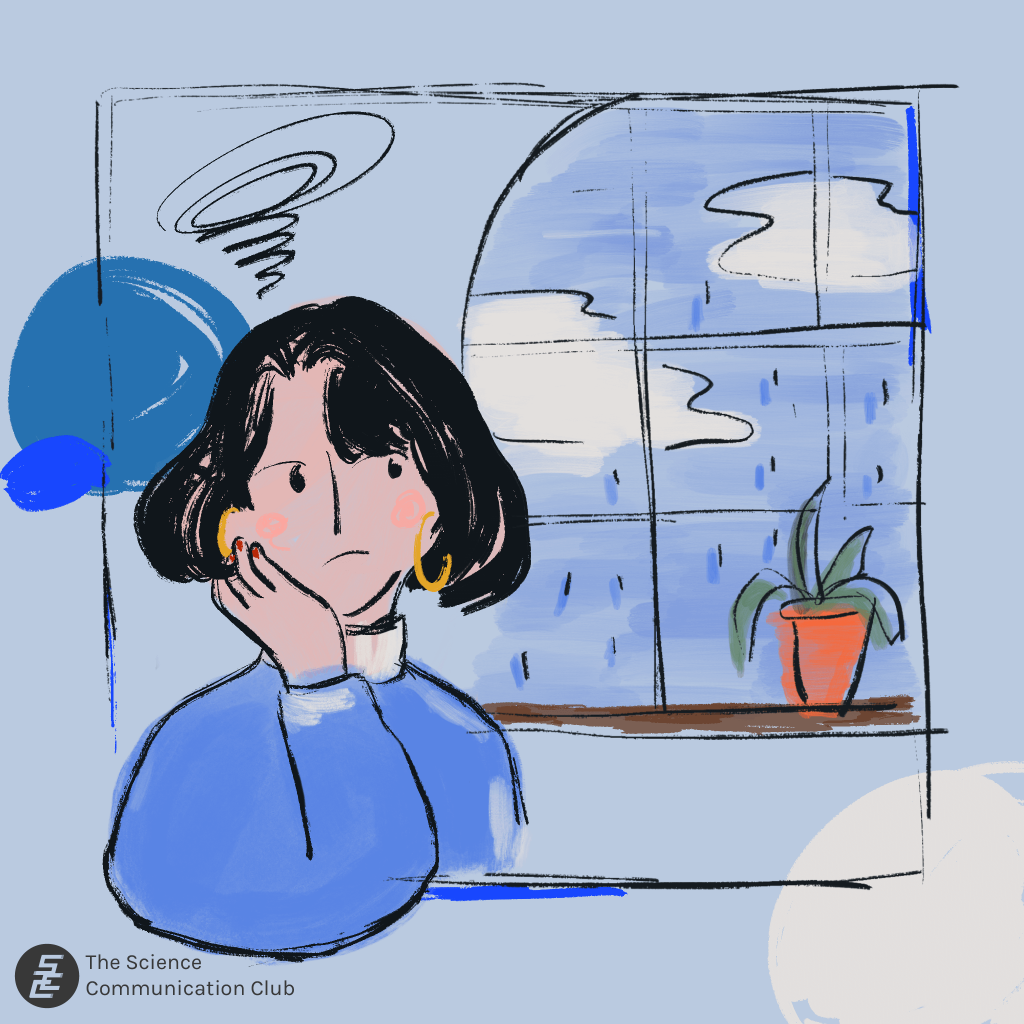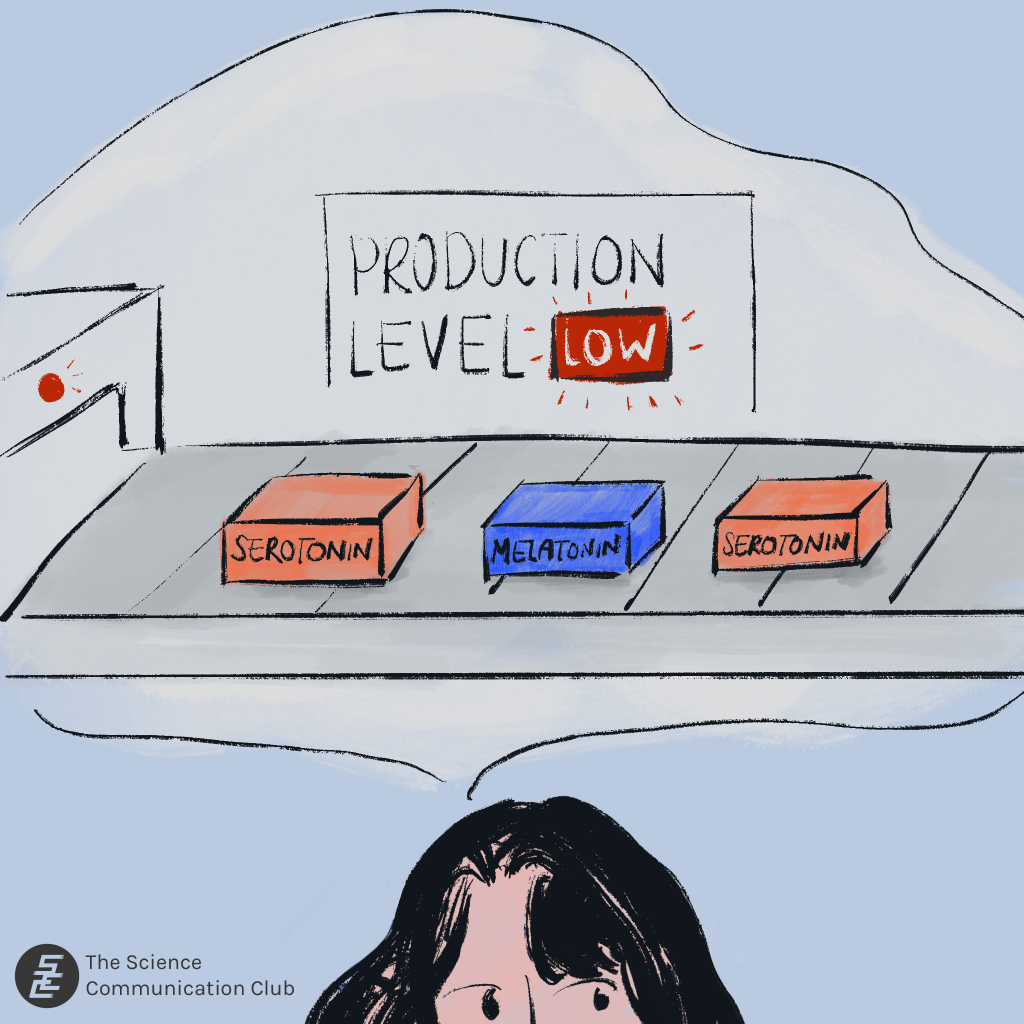
Written by Quinn Lui
Illustrated by Tammy Lee
After the relentless heat of summer, it’s no surprise if you’re looking forward to fall and its cooler weather. Whether your favourite part of this season is bundling up in cozy knitwear, cupping your hands around a delicious hot drink, or taking in the gorgeous sight of changing leaves, your wait is over! Unfortunately for many people, these perks come hand-in-hand with the threat of seasonal affective disorder (SAD).
SAD is a form of depression, a mental health condition that can manifest as a range of behavioural or mood-related symptoms. Some of the most common and well-known symptoms include: a persistent low mood, difficulty concentrating, decreased energy, a loss of interest in your previous hobbies, and feelings of guilt, uselessness, or hopelessness. While most of this list might sound familiar to anyone who experiences depression, what sets SAD apart is its timing. Other types of depression may rear their heads at any point in the year, but for people with SAD, a significant change in their mood or behaviour—also known as a depressive episode—comes as the seasons shift.
Notably, it’s possible for someone who already experiences another form of depression to also be affected by SAD. In fact, up to 20% of people with major depression might exhibit a cycle of symptoms that resembles SAD, though they aren’t necessarily diagnosed separately. Having a family member with any form of depression can also increase someone’s risk of experiencing SAD.
Most people associate SAD with the colder months, which is why it’s sometimes known as winter depression or the winter blues. However, by definition, SAD symptoms can also crop up in the summer rather than winter months. The two types are associated with slightly different symptoms. For example, someone experiencing SAD in the winter might experience an unusual uptick in fatigue and food cravings—almost like their body is preparing for hibernation. Meanwhile, summer-pattern SAD can take the form of a decreased appetite, with sleep being hampered by increased insomnia, restlessness, or anxiety.
Though the potential causes of depression are complex and varied, one trigger for SAD could be the changing amount of daylight that accompanies a turn in the seasons. Fluctuating sunlight exposure could affect the production of serotonin and melatonin, which are two types of brain chemicals known as neurotransmitters. Serotonin helps regulate your mood, while melatonin controls your sleep-wake cycle. When these neurotransmitters aren’t at the correct level, it can lead to the mood and sleep problems associated with SAD.

Another theory suggests that SAD might stem from social factors. The winter holiday season can be an incredibly stressful and exhausting time for some, while others may spend the end of the year cooped up alone in their homes. In both of these situations, a low mood can easily take root before worsening into a full-blown depressive slump.
However, only a few of the possible explanations for SAD have been consistently supported by research. Furthermore, most of them are linked to winter-pattern SAD, even though some people experience the disorder during summer instead. Ultimately, for people who are struggling with symptoms of SAD, the root cause may be less important than the effects they’re experiencing.
So how can they cope? As with other forms of depression, many people might seek out counselling or medication. Preventative measures, like making sure to get more exercise when you first notice that you’ve become more sluggish, can also help. More uniquely, light therapy seems to be a fairly effective treatment for many cases of SAD. During light therapy, you sit in front of a box which emits extremely bright artificial light. It’s meant to make up for the lack of sunlight we get during the winter months. Light therapy lamps are actually available for UofT students to freely use on several floors of Robarts Library!
Note: whether you’ve been diagnosed with a depressive disorder or not, the darker and colder days can take their toll on anyone, especially as the academic semester trundles on. Aside from Robarts’ light lamps, various resources are available at UofT to help support your well-being. If you think you might need or want help, please check out UofT’s Student Mental Health Resource, which also includes a list of non-university-affiliated providers here. You can also chat with Navi if you’d like a guide to walk you through the offerings at your disposal.
Sources:
- Canadian Psychological Association. (2020, December 31.) “Psychology Works” Fact Sheet: Seasonal Affective Disorder (Depression with Seasonal Pattern). https://cpa.ca/psychology-works-fact-sheet-seasonal-affective-disorder-depression-with-seasonal-pattern/
- Galima, S. V., Vogel, S. R., & Kowalski, A. W. (2020). Seasonal affective disorder: Common questions and answers. Am Fam Physician, 102(11), 668-672.
- Howe, Erin. (2014, November 3.) Moving the clocks back and seasonal affective disorder or SAD. Utoronto.ca. https://www.utoronto.ca/news/moving-clocks-back-and-seasonal-affective-disorder-or-sad
- National Institute of Mental Health. Seasonal affective disorder. https://www.nimh.nih.gov/health/publications/seasonal-affective-disorder